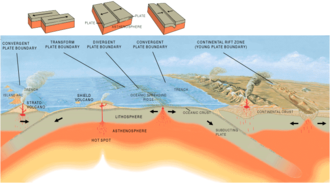
| Part of a series on |
| Earthquakes |
|---|
 |
A submarine, undersea, or underwater earthquake is an earthquake that occurs underwater at the bottom of a body of water, especially an ocean. They are the leading cause of tsunamis. The magnitude can be measured scientifically by the use of the moment magnitude scale and the intensity can be assigned using the Mercalli intensity scale.
Contents
- Tectonic plate boundaries
- Convergent plate boundary
- Transform plate boundary
- Divergent plate boundary
- List of major submarine earthquakes
- Storm-caused earthquakes
- See also
- References
Understanding plate tectonics helps to explain the cause of submarine earthquakes. The Earth's surface or lithosphere comprises tectonic plates which average approximately 80 km (50 mi) in thickness, and are continuously moving very slowly upon a bed of magma in the asthenosphere and inner mantle. The plates converge upon one another, and one subducts below the other, or, where there is only shear stress, move horizontally past each other (see transform plate boundary below). Little movements called fault creep are minor and not measurable. The plates meet with each other, and if rough spots cause the movement to stop at the edges, the motion of the plates continue. When the rough spots can no longer hold, the sudden release of the built-up motion releases, and the sudden movement under the sea floor causes a submarine earthquake. This area of slippage both horizontally and vertically is called the epicenter, and has the highest magnitude, and causes the greatest damage.
As with a continental earthquake the severity of the damage is not often caused by the earthquake at the rift zone, but rather by events which are triggered by the earthquake. Where a continental earthquake will cause damage and loss of life on land from fires, damaged structures, and flying objects; a submarine earthquake alters the seabed, resulting in a series of waves, and depending on the length and magnitude of the earthquake, tsunami, which bear down on coastal cities causing property damage and loss of life.
Submarine earthquakes can also damage submarine communications cables, leading to widespread disruption of the Internet and international telephone network in those areas. This is particularly common in Asia, where many submarine links cross submarine earthquake zones along Pacific Ring of Fire.

